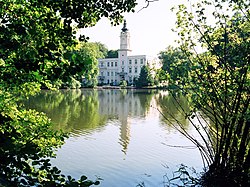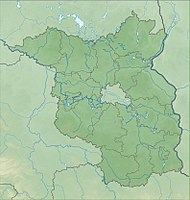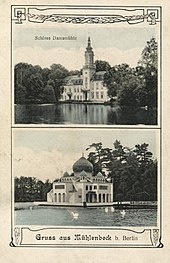Dammsmühle Castle
| Dammsmühle Castle | ||
|---|---|---|
 North-east side of the castle over the mill pond |
||
| Data | ||
| place | Schönwalde | |
| architect | Gustav Erdmann and Ernst Spindler | |
| Construction year | 1896 (on today's floor plan) | |
| Coordinates | 52 ° 41 '38 " N , 13 ° 24' 27" E | |
|
|
||
Dammsmühle Castle is a neo-baroque mansion with a surrounding area of 28 hectares in the Barnim district of Brandenburg . It is located in the area of Schönwalde in the Wandlitz community .
history
At the site of today's Dammsmühle Castle, there was a mill as early as the 16th century, which probably belonged to the Cistercian monastery Lehnin , which had been in operation since the 14th / 15th centuries . Owned the lands of the area in the 18th century. During the construction of a new mill in the middle of the 18th century, the builders came across millstones from that time that bore traces of a fire. Around 1650 the Cistercian mill was replaced by a hunting lodge built by order of the Great Elector Friedrich Wilhelm .
The site of the former mill was acquired in 1755 by the Berlin leather manufacturer Peter Friedrich Damm , who had the sole right to supply the royal Prussian army with uniform parts made of chamois leather . He erected the building of Dammsmühle Castle in 1768 as a two-story palace in a wooded area in Barnim, west of the village of Schönwalde near Lake Mühlenbeck . Queen Elisabeth Christine , the wife of Friedrich II, is said to have stayed there several times. In keeping with the fashion of the Rococo period, the palace had a theater hall on the upper floor. After Damm's death, the building fell into disrepair because there was no heir. In a foreclosure auction in 1894, Lieutenant Adolf Wollank acquired the property and expanded it into a mansion. He left the building of the Berlin architect Gustav Erdmann and Ernst Spindler in neo-baroque rebuild style, top up , provided with an extension and a tower with onion dome Add. On an artificial island in the mill pond, he had a building in the form of a mosque built, inside of which there was a large dance hall.
After Adolf Wollank's death on April 27, 1915, his brother Otto Wollank managed the castle, which was now named Dammsmühle after its builder. Adolf Wollank was buried on the grounds of the palace in the Hubertus pavilion opposite the palace that he had commissioned. The pavilion no longer exists today. The castle was sold in 1919 to the businessman Hermann Zirkel from (Berlin-) Zehlendorf .
Ten years later, in 1929, the British Harry Goodwin Hart , then director of Unilever , bought the property. After Hart had to leave Germany with his Jewish wife in 1938, he was expropriated in 1940. Now the castle came into the possession of Heinrich Himmler . From January to July 1943, 20 to 25 prisoners from the Sachsenhausen concentration camp were used for construction and maintenance work. Shortly before the end of the war, the commander of the Wehrmacht Army Group “Vistula” defending Berlin, Colonel General Gotthard Heinrici , set up his headquarters here.
After the war ended in 1945 , the castle was occupied by the Red Army . In 1959 the GDR Ministry for State Security took over the house and used it as a hunting lodge until 1989 . During this time it was rebuilt, among other things, the existing mansard roof was replaced by a full storey in 1968 . After the reunification , the castle was used as a hotel for a short time.
In 1997 the property was returned to Harry Goodwin Hart's heirs who sold the property. The castle fell into disrepair due to years of vacancy.
In 2000, the area was used by a Berlin concert organizer (Messe & Eventbau Reissig company headquarters in Teltow-Fläming Brb) until October 2003 for open-air concerts of various genres, which annually attracted around 30,000 concert visitors and thus increased the level of awareness of the area. In 2003 the Nation of Gondwana open-air music festival took place there . The planned concept of expanding Dammsmühle Castle into an event and local recreation facility was ultimately not implemented. The site was thus exposed to further deterioration, damage from vandalism and illegal waste dumping.
In 2008 the property was transferred to Schlossgut Dammsmühle Management GmbH , who wanted to develop the site as a cultural adventure world with free access for the public. In the following year, this company concluded a long-term lease with the private citizen Gerd Matern. Matern actually began to redesign the palace and the park step by step. In addition, numerous events have been organized on site since early summer 2009, such as a castle beer garden brunch , a 3-lake run for everyone around the mill pond, a classic car show with a rock concert , a haunted festival, etc. In addition, the bathing tradition was revived The establishment of a gourmet restaurant, a nightclub and a café in the former bowling alley is also planned in the rooms of the castle. In the meantime, the operating company has ceased its activities and filed for bankruptcy.
In 2017 the castle was sold to Berlin entrepreneurs who are planning a hotel with a spa area and restaurants there; the development plan procedure was opened in 2020.
timeline
- 1650: A hunting lodge for the Great Elector is built on the site of today's castle.
- 1746: The soldier Knape applies for the construction of a mill.
- 1747: Müller Grüwel (Mönchmühle) receives permission to build instead of Knape.
- 1753: Schönwalde is founded.
- 1755: The manufacturer Damm acquires the “Neue Mühle” built a few years earlier from the indebted Grüwel.
- 1776: After Damm's death, his widow remains the owner until 1802.
- 1805: Dammsmühle falls victim to a fire.
- 1812: Napoleon stays on the Mühlenbeck Amtshof in Dammsmühle while inspecting a new regiment.
- 1824: Dammsmühle is sold to the London merchant Heese.
- 1832: JJ Th. Schaeffer becomes the new owner.
- 1840: Friedrich Wilhelm IV refuses an offer to buy, Dammsmühle degenerates into an entertainment venue around 1890.
- 1894: After the purchase by Lieutenant Adolf Wollank, the manor was given its present-day appearance through the construction of a second house and a connecting building in the form of a tower, supplemented by the construction of a floating pavilion in an oriental style .
- 1910: Meeting of Kaiser Wilhelm II with Tsar Nikolaus II in Dammsmühle.
- 1915: After Wollank's death, his brother Otto von Wollank manages Dammsmühle Castle.
- 1919: The businessman Hermann Zirkel acquires the property.
- 1929: Dammsmühle is used as a location for the film "His best friend" by Ariel-Film GmbH with the main actor Harry Piel .
- 1929: The director of the British soap company Unilever, Harry Goodwin Hart, purchases the property.
- 1938: Hart has to leave Germany with his wife.
- 1940: After the area was confiscated as "enemy property" by the Nazi regime, it was officially subordinate to the Reichsführer of the SS, Heinrich Himmler. It is not known whether he was ever there.
- 1943: A total of 25 male prisoners were deployed between January 2 and July 3 in "Object 1091", which at that time was a satellite camp of the Sachsenhausen concentration camp. According to reports from those affected, the external command was a comparatively minor evil.
- 1945: The Red Army occupies Dammsmühle; Initially used as a hospital, the building later became a rest home and casino for Soviet officers.
- 1951: After handing over to the German authorities, the property is used as an educational facility, recreation home and pioneer camp.
- 1958: The council of the community of Schönwalde gains administrative sovereignty over Dammsmühle.
- 1959: The Stasi seizes the castle, which now serves as a guest house, among other things.
- 1968–1978: Major modifications to the castle are carried out (full floor with roof garden instead of mansard roof; construction of underground bunkers on the site)
- 1990: The turning point ends the presence of the Stasi at Dammsmühle.
- 1991: The castle is the backdrop for the WDR multi-part series "Haus am See" with Hildegard Knef , Anita Kupsch , Ursela Monn and others. a.
- 2000–2003: Electric Kingdom / Low Spirit OpenAir series (including Westbam , Carl Cox ), Blue Hour Live with Anja Schneider Radio Fritz , MTV Campus Tour UK., Casino Royale, Ostgut , Loveparade Chillout Lounge
- 2003: Summer Open Air a. a. Paul Kalkbrenner , Northern-Lite
- 2003: Rockfestival Dammsmühle u. a. Doro Pesch , Iron Maiden
- 2008: Insolvency of the operating company Dammsmühle Management GmbH
- 2017: Sale to Berlin entrepreneurs
Film set
The picturesque property has served as a film set several times , the following films and series episodes were shot here:
- 1929: His best friend with Harry Piel
- 1934: The cousin from Dingsda , director Georg Zoch
- 1991: Haus am See , ARD series
- 2000: All children need love , produced by ARD , director Karsten Wichniarz
- 2002: Shots , diploma thesis from the Stuttgart Media University , director Achim Hasenberg
- 2006: Virus Undead
- 2018: Police call 110: Democracy dies in darkness , TV film
literature
- Gerhard Zirke: Dammsmühle. Commerce, politics, frivolity in the Haus am See. Brandenburg publishing house, 1992.
- Horst Hup, Maria Müller, Inge Jahnke: A castle in the market. Memories of Dammsmühle. 4th revised edition, Druckhaus Berlin-Mitte, Berlin 1993.
- Sonja Wüsten: Märkische Miniatures. Das Neue Berlin Verlagsgesellschaft mbH, Berlin 2001, ISBN 3-360-00968-1 .
- Claus-Dieter Steyer: The forgotten fairytale castle . In: Der Tagesspiegel from May 2, 2004
Web links
Individual evidence
- ↑ Horst Hup, Maria Müller, Inge Jahnke: A castle in the market. Memories of Dammsmühle. 4th revised edition, 1993, p. 5.
- ↑ Horst Hup, Maria Müller, Inge Jahnke: A castle in the market. Memories of Dammsmühle. 4th revised edition, 1993, p. 25, p. 32.
- ↑ Schönwalder Journal, Bürgerzeitung von Schönwalde , 12th year 2008, p. 30:
- ↑ Wolfgang Benz , Barbara Distel (ed.): The place of terror . History of the National Socialist Concentration Camps. Volume 3, Sachsenhausen, Buchenwald. CH Beck, Munich 2006, ISBN 3-406-52963-1 , pp. 141-143.
- ↑ Richard Rother: Techno insiders flee to the outdoor dance . In: The daily newspaper . July 14, 2003, ISSN 0931-9085 , p. 21 ( taz.de [accessed June 20, 2018]).
- ↑ Excursion to “Mielke's Bathtub”. In: Wandlitz, Citizen and Visitor Information 2009/2010 , p. 18 ff.
- ↑ Morgenpost: This is how the ruin should become a luxury hotel
- ↑ MAZ: A tourist gem is kissed awake
- ^ Website of the dissolved Dammsmühle Management GmbH , accessed on August 3, 2015



